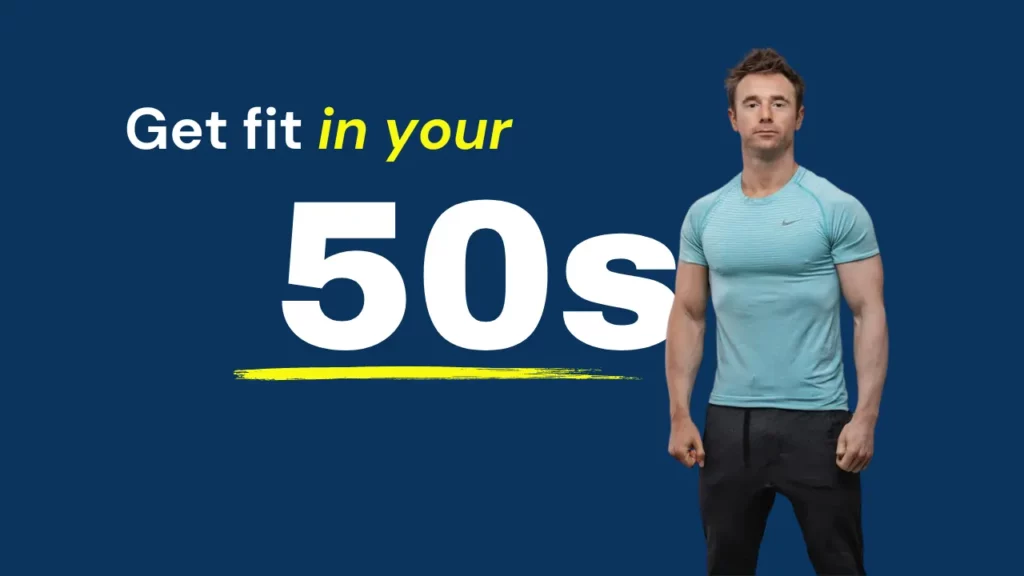
Your 50s are a time when a significant switch to thinking of exercise as an investment in the future would be a smart move. Often simple adaptations to your workouts and making sure that you have all your bases covered can really help you not just stay in great shape but also protect your ability to move and live as you want to in the decades to come.
Extending your ‘healthspan’
If you haven’t heard the term before, this is the term used to describe the length of the period of your life in which you have full health, and function and are free of any debilitating effects of ageing.
I believe your 50’s should be dedicated to this pursuit, rendering ‘getting in shape’ more of an output of your activity and healthy lifestyle choices, as opposed to the main driver for them.
One of the most powerful techniques for enhancing your motivation to exercise and boost your ‘healthspan’ is to deliberately spend time thinking about certain poignant moments in life.
Special moments that you believe being in great health & fitness would help you access and enjoy. Conversely, you could use the reverse of the process to focus on moments that could be taken away from you should you never make a concerted effort toward improving your health & fitness.
These could be things like your ability to be active with your children or grandchildren, being fully mobile and energetic in your romantic relationships, having enough energy to push forward with the success of your career or simply being fit and strong enough to be out and about for activities like hiking and cycling.
This can be an emotional exercise. That’s a good thing because you can tap into the mental imagery and emotional charge of these moments. Storing these in your memory or ‘anchoring’ them for deployment on the inevitable tougher days in which you just don’t feel like working out. This is an effective neuro-linguistic programming technique. In my experience coaching clients and holding them accountable to their intention to change, this can
Is it harder to get in shape in your 50s?
Whilst I’ve argued that the real goal of the 50s ought to be largely health-related rather than driven by aesthetics, I am of course, enlisted by my online personal training clients in their 50s to help them get in excellent physical shape.
The burning question the majority of people have is whether it’s going to be much harder to get in shape in your 50s than previously. My answer is generally “not necessarily” It’s going to come down to training smart and staying injury-free. After working for 14 years as a personal trainer, I’ve now coached many people to a leaner, healthier and more athletic physique, to inform that response.
Studies have shown that we do start to lose muscle mass after age 30, but only at a rate of 3-8% per decade which isn’t a rate I would consider a serious impediment to success. Ultimately your body is still more than capable of great things throughout your 50s. Accounting for a few age-specific nuances, whether you personally will be in great shape through your 50s is going to come down to clearly making exercise a priority and staying consistent with it. Don’t get me wrong, a meniscus tear at 50 just won’t have the same recovery rate as it would have at 20, but that isn’t the point, the point is if you’re able to train smart, recover well and avoid unnecessary injury risk you can certainly achieve very impressive fitness results in your 50s.
We’ve discussed losing muscle, but I am also often asked how to gain muscle after 50. Essentially, it’ll be done in the same way it always has been, with some nuanced considerations for assessing fatigue and the need for rest. Then steering more into multi-joint lifts to protect your range of motion for the future. But essentially the same tried and tested fundamentals will be true no matter the training protocol, if you want to gain muscle you need to track your workouts, practice progressive overload, eat to sustain your goal and get enough rest. That’s as true at 50 as it was at 20.
Addressing menopause
Of course, as I’m confirming that it’s still relatively easy to lose weight and get in shape during your 50’s as it is in earlier years, I would be remiss not to acknowledge that some of the hormonal changes that occur during menopause can and will make your fitness goals more challenging to accomplish.
These changes can include oestrogen fluctuations (which can lead to fat accumulation in either direction), lower energy, poorer sleep, and a loss of muscle mass leading to a lower metabolic rate which if calorie intake remains stable over time will lead to weight gain.
The only way to combat these changes (without medical assistance) is to double down on healthy lifestyle changes, any attempt at restrictive diets and over-exercise in order to fast-track results should be avoided, and will likely yield only very short-lived results.
You’ll then soon be back at a point where the restriction cannot be sustained and may face a severe bounce-back, Also bear in mind that with severe caloric restriction, you are leaving yourself open to losing muscle, which would further exacerbate the effects of menopause on your metabolism. Actually I would say from experience training many clients through this period that restrictive dieting would be the number one biggest mistake you could make. As we get older, it’s not going to get any easier to gain muscle, hormonal changes through menopause exacerbate this, so dieting yourself down to a loss of muscle will be extremely detrimental. If dieting has always been your go-to form of weight loss, it is just no longer going to serve you. This can be a frustrating time, and perseverance is going to be key.
Andropause
The andropause is a term given to the process of a man’s testosterone slowly declining with age, which happens at a rate of approximately 1% per year after age 40. A drop in testosterone can have big effects on energy, mood, and even personality factors and will influence your body composition quite substantially.
The extent to which you will feel that 1% decline will depend on your lifestyle choices and your baseline level of testosterone before the decline. Testosterone replacement therapy may be an option which is a line of enquiry to take up with a trusted medical adviser. Of course that won’t be appropriate for everyone so in the absence of TRT you’ll be best served taking lifestyle steps to naturally enhance your level of testosterone and to avoid actions that would suppress it.
Consider a coach
Your 50s could be a good time to work with a fitness coach experienced with people in your age range. Because mistakes can be less forgiving during this decade than they were before, you absolutely want to reduce the risk of injury, and unnecessary wear and tear. You also need to ensure you’re eating to support health, and investing time into mobility training. So my advice would be to seek guidance on your goals to avoid wasted time and effort.
Exercise in your 50s
Are there dos and don’ts?
If you’ve been reading around the internet about how you should best go about training in your 50s, you’ll note that much of the information is very cautionary. Suggesting that you avoid sprints, plyometrics, overhead movements and certain isolation exercises.
Whilst this can be good advice, It’s important to remember those articles are often being written for an entry point to exercise, which let’s say is your 50th birthday for arguments sake. Well we’re talking about a whole decade, so we have ten years to make progress on that, so of course, more is going to be possible after consistent training than would be if you’re just starting out or returning to exercise after a lay-off. What I’m getting at is that you can easily finish this decade in much better condition than you start it.
Whilst you shouldn’t be taking unnecessary risks in your workouts, what you will be capable of is going to progress over time. And you might be surprised just how strong, fit and mobile you can get over the next ten years.
Of course, if you’re already in fantastic shape and have been training well throughout your whole life and then turn 50, should you drop all of the types of workouts listed above if you’ve been doing them throughout your forties? No, of course not, that would essentially be like inviting an old person to come and live in your body decades early, if you’ve maintained a high level of fitness and athleticism in your 40s the chances are you will be able to carry that through your 50s too.
However, I would caution against trying to reprise the ability and conditioning you had in previous decades, at least in the early stages of a return to training. Purely because it would be easy to find yourself in a position where you have a positive frame of reference for a certain level of performance but have nowhere near the conditioning to perform or recover from that type of training upon your return.
I say that to reassure you that there is really nothing you ‘can’t’ do in your 50’s purely because of your age. And that the extent to which you ‘should’ do certain things in your 50’s will depend on your intuitive understanding of your body and the amount of prerequisite groundwork and conditioning you’re willing to put in to recover ground on your previous ability. Of course, you may be able to get an informed opinion on this by finding a great personal trainer or fitness coach.
To be clear then, if you’re reading this knowing you’re out of shape, stiff and unconditioned at the moment should you go out and run 100m track sprints or start doing HIIT kettlebell work, just because we know it ‘works’?
Of course not, While those are very effective workouts, they are likely to be counterproductive to you right now because of your contextual lack of conditioning. It’s all relative to where you are at any given time. Equally though, it would not be faithful to my experience and observations about what works as a personal trainer to state that you will not be able to or should not do these workouts ever again, that’s in your hands.
Let’s take a look at some age-specific considerations to help you get to exactly where you want to be with your health & fitness in your 50s.
Prioritise Body recomposition
Many of my online personal training clients will approach me looking to gain muscle and lose body fat. This is generally known as body recomposition and is the primary goal I help people achieve in their 50s.
The basic methodology of this is the same in your 50s as it would have been in earlier years. Progressive overload will force adaptation as long as you can recover from the stimulus which equates to muscle gain. Likewise, steady-state cardio will support your fat loss efforts without accompanying fatigue and short HIIT training can be implemented to benefit from the ‘thermic effect of exercise’
To achieve recomposition we will be pursuing contrast, progressive overload, and recovery. This can be massively miscalculated, so ensure the training is appropriate to your current conditioning and appropriate to your overall lifestyle taking into account health issues; the amount of sleep you’re getting and the amount of stress you’ve been under in the run-up to starting your new fitness plan, lifestyle measures like a mindfulness practice are often a welcome addition.
Exercise vs Rest on 1:1 ratio
One interesting mental model with which to approach your health & fitness is to start to think of exercise and rest on a 1:1 ratio at least until you’re back to fitness.
What I mean by this is that you need to consider rest of equal importance to your training (after all adaptation takes place during rest). An easy way to do this is to train one day and take the next off to recover, this pretty much guarantees that you build a good deal of recovery into your week.
One thing to bear in mind is that a rest day is not the same thing as a day of complete inactivity, as humans we’re evolved to move every day regardless of any particular training goals. Simply remove the outcome focus and need for any result as such, and enjoy more passive activities such as walking, cycling and hobby sports on your non-training days. You can try this ten-minute follow-along movement practice to add light movement to your routine.
Primal patterns & suggested exercises
To expand beyond the normal aesthetic fitness goals that may have been the driving force for your fitness efforts in earlier decades, I would suggest that you make simple adaptations to your workouts and maybe even introduce some novel exercises that will really help you protect and enhance your functional movement.
I first came across the concept via the work of one of the godfathers of the fitness industry and holistic lifestyle coach, Paul Chek. Others have also run with and expanded the concept.
A primal movement pattern is essentially a natural human movement pattern that we need to invest in and protect to maintain functional activities throughout our daily lives. In essence, a movement that naturally find ourselves doing as part of our day-to-day lives.
Ideally, you’ll want to make sure you are doing these movements as often as you can, never allowing a long distance to accrue between doing them, this way you maintain of your ability to perform them.
Let’s have a look at them and how you can make simple adaptations and not affect your overall fitness progress:
Push = Consider replacing some of your traditional chest pushing movements with a cable push-pull exercise.
Pull = Consider replacing some fixed latissimus dorsi pulling movements, like the classic lat pulldown, with pulling a heavy weight on a rope every now and then.
Twist = Often rotation is completely absent from many modern workout programs, cable woodchoppers are an excellent addition.
Squat = Consider a Sott’s press or squat and press exercises to replace your big hack squats or an alternative to the typical heavy barbell squat.
Lunge = Make sure your leg workouts aren’t too squat heavy, and incorporate lunges into your leg days, these are functional movements you need for traversing different levels of terrain, so don’t neglect them.
Bend = Consider making a bending motion a part of your warmup routine for every workout, over time as you can get more conditioned you can even load these bends, but only do this under supervision.
Gait = Whilst you’ll walk every day anyway, experiment with a different gait from jogging and sprinting (once conditioned) to experimenting with Fartlek runs and hill work.
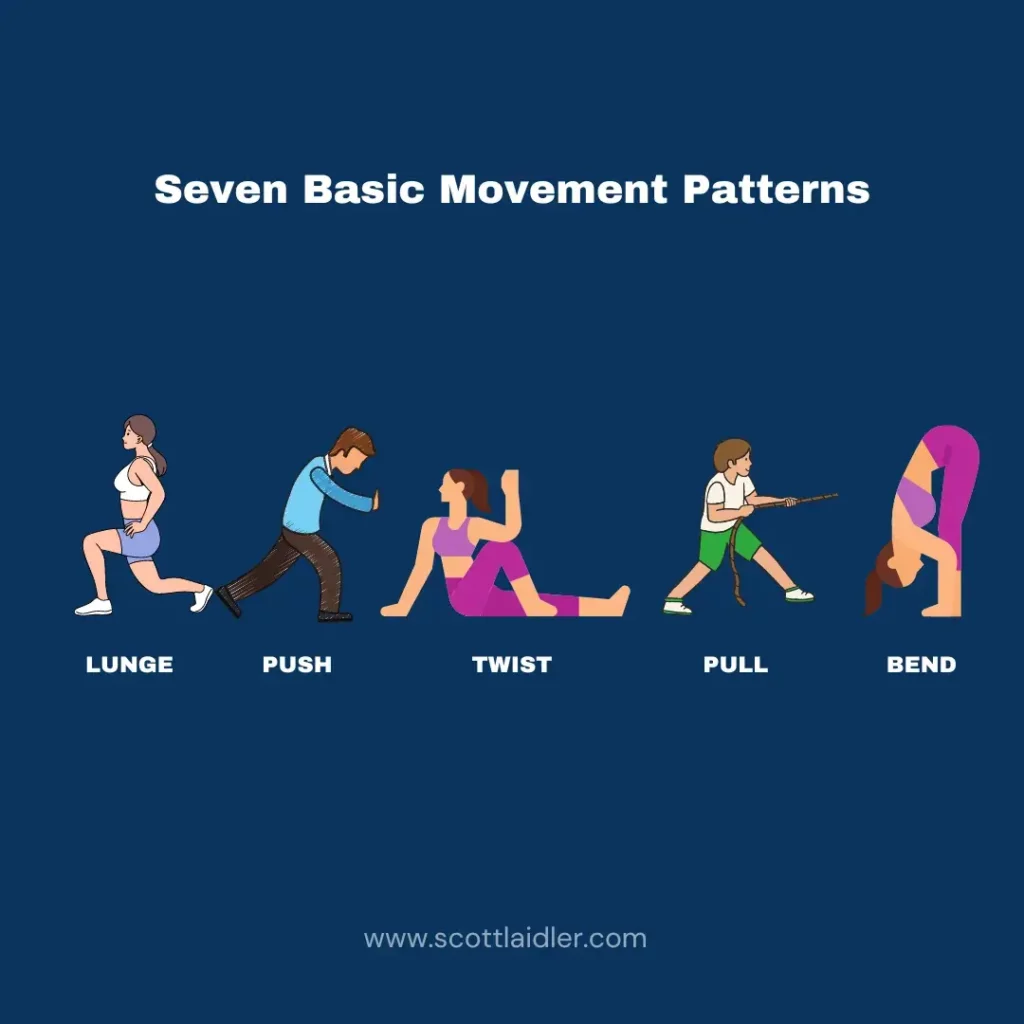
Honourable mention, (and a favourite of mine):
Throw = Consider adding some functional throwing movements into your workouts. An easy way of doing this is to use a medicine ball either against a wall or out in an open field where you could also integrate throwing and chasing.
I actually have a fairly heavy cannonball I found in the east of England, that I take to woodland areas for this purpose. It’s very portable and I look a lot like the chap below doing it…
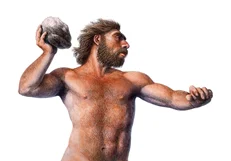
Nutrition: More than just the numbers
Your 50s are an excellent time to start to consider the influence the food you eat has on your overall level of health, beyond just changing your composition.
Of course, you’ll want to take care of the basics at any age, i.e., knowing how many calories you are eating and what the right macronutrient distribution is for your goal. You might be shocked by how far off you are from the optimal targets and ranges even when you’re eating really healthy food.
Suggested workout week:
Mon – Total body multi-joint exercises (moderate rep range, low volume)
Tues – Yoga / Pilates, sports of extended movement
Wed – Counterpart to Monday with different exercise selection (moderate rep range, low volume)
Thu – Novel Movement ‘play’ session (a workout where the intention is to explore movement)
Fri – Short low impact HIIT (<20minutes)
Sat – Sports / recreational activity
Sun – Rest
Notice that whilst we’re not moving through the week on a strictly training day vs resting day basis, only Monday & Wednesday represent a significant load on the central nervous system which would need significant recovery. Friday would be a tough workout but mild on the body and every other day I would argue would generate a net increase in energy or represent what you might consider a ‘work-in’.
Understanding your ideal caloric intake for your goals is one of the basic facets of nutrition you should have covered and one of the first things I take care of for my clients, so for the remainder of this article, let’s take having all of that in place as red.
If you haven’t already filled it out, I will calculate your numbers for you on my free health audit.
So let’s take having all of that in order as read, there are some other considerations you should take in your 50s to consider your overall health.
Managing Blood Sugar
Being mindful of your body’s insulin response to your meals is going to play a large role in keeping your body in good health, firstly it’ll be the greatest preventative weapon you can deploy against becoming diabetic or pre-diabetic (which is reversible by the way), it’ll also play a huge role in staying lean and managing your energy levels.
Tip: Calories and Macronutrient distribution don’t have to be 100% spot on every day, I would settle for 80% accuracy overall on calories + macronutrient distribution than 100% on one and no consideration of the other. This way you are thinking in terms of a mental model for healthy eating, rather than dogmatic adherence to a diet plan.
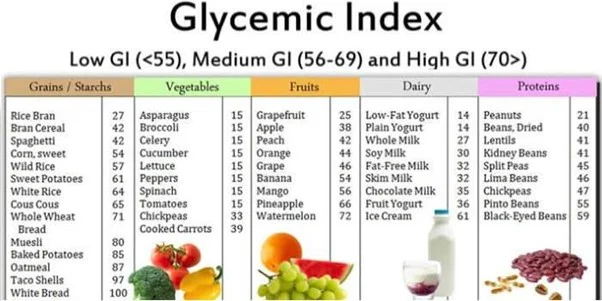
This chart shows the glycemic index of various foods. Which is essentially a way of classifying foods. The higher the number the quicker it raises blood sugar.
If you are eating foods containing a lot of highly processed sugar, you will constantly be spiking your blood sugar. This will cause energy turbulence and set you up for fat gain. At a minimum, the loss of body fat will be more difficult to achieve. The idea here is to minimise this turbulence and allow your body to have a balanced release of energy.
Opt for low to moderate glycemic index carbohydrates and when possible eat carbs with proteins and fats which will help lower the original glycemic index of the original carbohydrate.
Tip: Try to strategically time high glycaemic index foods before and after exercise as that’ll be when your body is best poised to make use of them. Avoid processed, refined sugar whenever you can.
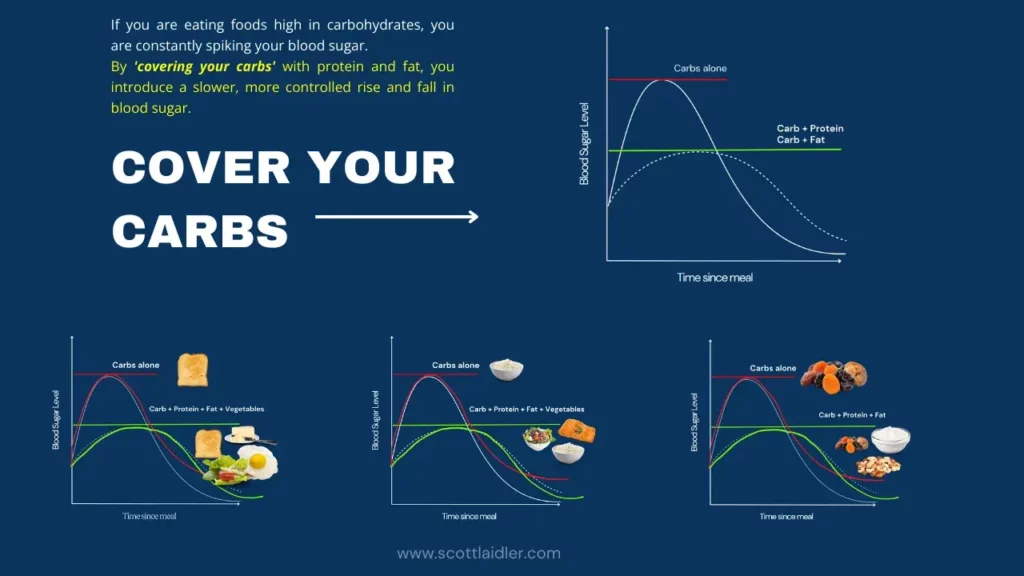
Focus on inflammation
I sometimes think in life it’s useful to think of developing a concerted focus on certain concepts and develop what we might consider a ‘consciousness’ of them. For example, if you wanted to get wealthy, you might work on a ‘money consciousness’ in that you’d think about what was going out and what was coming in and always be looking for ways you might be able to offer value to the marketplace for which you could be compensated. Before long, you would begin to notice opportunities and ideas you hadn’t previously been attuned to.
Using this mental model, I suggest that you adopt an ‘inflammation consciousness’. I think this should be a priority because many of the big health issues in the modern world are diseases linked to inflammation. Unchecked inflammation is essentially an open invitation to illness and disease and we can gain some control of our level of inflammation by monitoring and improving various potential sources of inflammation.
Below are some of the frequent causes of inflammation:
- Work Pressure
- Medication
- Environmental Stressors
- Temperature Stressors
- Relationship Troubles
- Poor Digestion
- Inflammatory Foods
- Bad Posture
- Lack of Sleep
- Emotional Stress
Of course, to truly know your current level of inflammation in your body you would need to have a medical professional have a look at your bloodwork. One could consider this an excellent health initiative every 6 months to a year. If you do perhaps seek out a local practitioner who can offer you a C-reactive protein (CRP) test.
In the absence of bloodwork, this simple mental model of an ‘inflammation consciousness’ may help you take steps to keep your level of inflammation at a point below the threshold at which you might start to see a reduction in some common symptoms that you may not have previously associated with inflammation. These might include frequent illness, rashes, digestive issues, fatigue, stiff joints etc.
One of the most influential factors listed above and also one of the easiest to control is avoiding an inflammatory diet.
As I advise my clients of all ages, you’ll want to ensure that you are taking steps to consume an anti-inflammatory diet, or at least not knowingly eat a pro-inflammatory one. In my view, this becomes progressively more important as we get older. If you can get on top of some of the above factors it might contribute to a reduction in systemic inflammation mentioned above and from an aesthetic standpoint, helps reduce your body’s tendency to retain water and store body fat.
Inflammatory foods to avoid may include:
- Refined sugar
- processed meats
- Fizzy drinks
- Processed milk
- Gluten (if you are sensitive to it)
- Dairy (if you are sensitive to it)
- Alcohol
Another important point here is to keep your protein intake adequate to preserve your existing muscle mass (alongside resistance training, fight off the nefarious though overestimated villain of sarcopenia). This doesn’t mean going overboard and eating like a bodybuilder; just make sure you have adequate amounts of quality high-protein foods such as lean meat, eggs, nuts, and seeds.
You may also want to start thinking about your ratios of fat to carbs. Many of us vastly overeat carbohydrates, especially in the evening, which gives our body a surplus of energy that we may fail to burn off. I can tell you from experience that when my inbound personal training clients share their food logs with me, before We’ve built them a meal plan they are often massively undereating protein, over-eating carbs and eating the less healthy types of fat.
As a result, the body converts the carbs into fat and stores it away for a rainy day (when you don’t have access to food) a great evolutionary function but unlikely to ever happen in the modern-day.
Eat for joint health
Both fish oil and Turmeric have been shown to possess impressive anti-inflammatory properties and are worthy considerations as supplements. Foods like nuts and seeds, cold-water fish, olive oil and certain root vegetables can also contribute to overall joint health.
Medicinal foods
Keep an eye out for the addition of certain herbs and spices that might be good for your overall health, either to address a specific problem or to generally just make incremental improvements. These small enhancements to your culinary repertoire may yield big benefits when it comes to your health.
Let’s take a look at a few examples:
- Thyme – A powerful antioxidant, which can support immune health
- Oregano – Contains Anti-bacterial properties which could help fight infections
- Ginger – May help lower blood sugars and may be useful in the battle against osteoporosis
- Garlic – Antifungal, Antibacterial and anti-viral properties make this popular flavour enhancer a powerful ally for all-round immune function.
And there are many, many more…. Remember nutrition is more than just making your macros work, sourcing quality ingredients and foods with medicinal or adaptogenic properties could really change what cooking and meal preparation means to you and your loved ones.
Final thoughts on exercise at 50
Overall, throughout your 50s your body is still capable of achieving great aesthetic change and the right lifestyle choices will carry you through into later life. One of the biggest battles I’ve observed with my clients in their 50s that I haven’t touched on yet is the battle to garner the belief that it’s still possible for them to lean up, gain muscle and regain good movement, which is more of a mental battle than it is a physical one.
Whilst I never advocate short-term strategies to achieve long-term goals, if belief is half the battle, it’s important to bag some early wins. Which I believe is best done with optimisation and contrast to the lifestyle you previously led on the way into a new regime. Contrast forces adaptation and that’s where you’ll achieve results. Investing in expert advice or carrying out adequate research will serve you well to get the initial momentum you need and prove to yourself that you can achieve your goals in your 50s and well beyond.